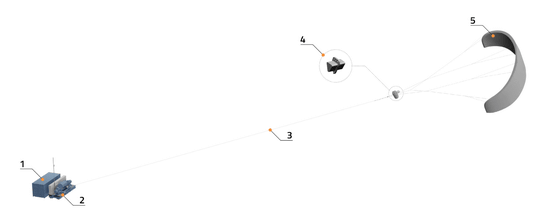The introduction of an ``aerial wind power generation system'' that generates electricity by flying kites high in the sky is underway.

In order to reduce carbon dioxide emissions, which cause climate change, renewable energies such as solar power generation and wind power generation are being introduced around the world.
The Hawk - Kitepower
https://thekitepower.com/the-hawk/
Flying Kites Deliver Container-Size Power Generation - IEEE Spectrum
https://spectrum.ieee.org/micro-wind-power-kitepower
The aerial wind power generation system 'Hawk' that Kitepower is planning to introduce has the following configuration. 1 is a lithium-ion battery that stores the generated electricity and has a capacity of 400kWh. Next to the battery is the ground station 2, which converts the kite's energy into electricity and sends it to the generator. 3 is the string that connects the ground station and the kite, and its length is 352m. 4 on the end of the string is attached to the unit that controls the kite. The kite number 5 is made of fiberglass, making it lightweight and durable.

It's small and a little hard to see, but it's a Hawk kite flying in the blue sky. The size is 60 m 2 and it can move at a maximum speed of 110 km / h. The average windmill for wind power generation is approximately 100m high, but Hawk's kite can reach a height of 350m, allowing it to receive stronger wind energy.

A container equipped with a battery and a ground station are placed in the grassland. Hawk's instantaneous power generation capacity is 40kW.

As the kite flies high in the air, the strings attached to it are pulled and a generator at the ground station generates electricity. When the string is pulled to its maximum, the ground station reels the string and rewinds the kite. The energy consumed to unwind this string is less than the energy generated, so there is no problem. One cycle of flying a kite and reeling it back takes about 100 seconds.
The advantage of Hawk is that it has a much smaller footprint than giant wind turbines or solar panels. Therefore, not only does it have little impact on the surrounding environment, but it can also be installed in tight spaces.
Kitepower is also preparing a proof of concept for `` Falcon '', a 100kW power generation system that is even larger than Hawk, and plans to launch it on the market from 2025 to 2026.
Kitepower's Hawk is not the first aerial wind power generation system, and in the past there was a project called 'Makani' promoted by Google. However, Makani left Google's parent company Alphabet in 2020.
``Makani'', which was developing a flying wind power generator, announces that it will become independent from Google's parent company Alphabet - GIGAZINE

Related Posts:
in Hardware, Posted by log1i_yk






